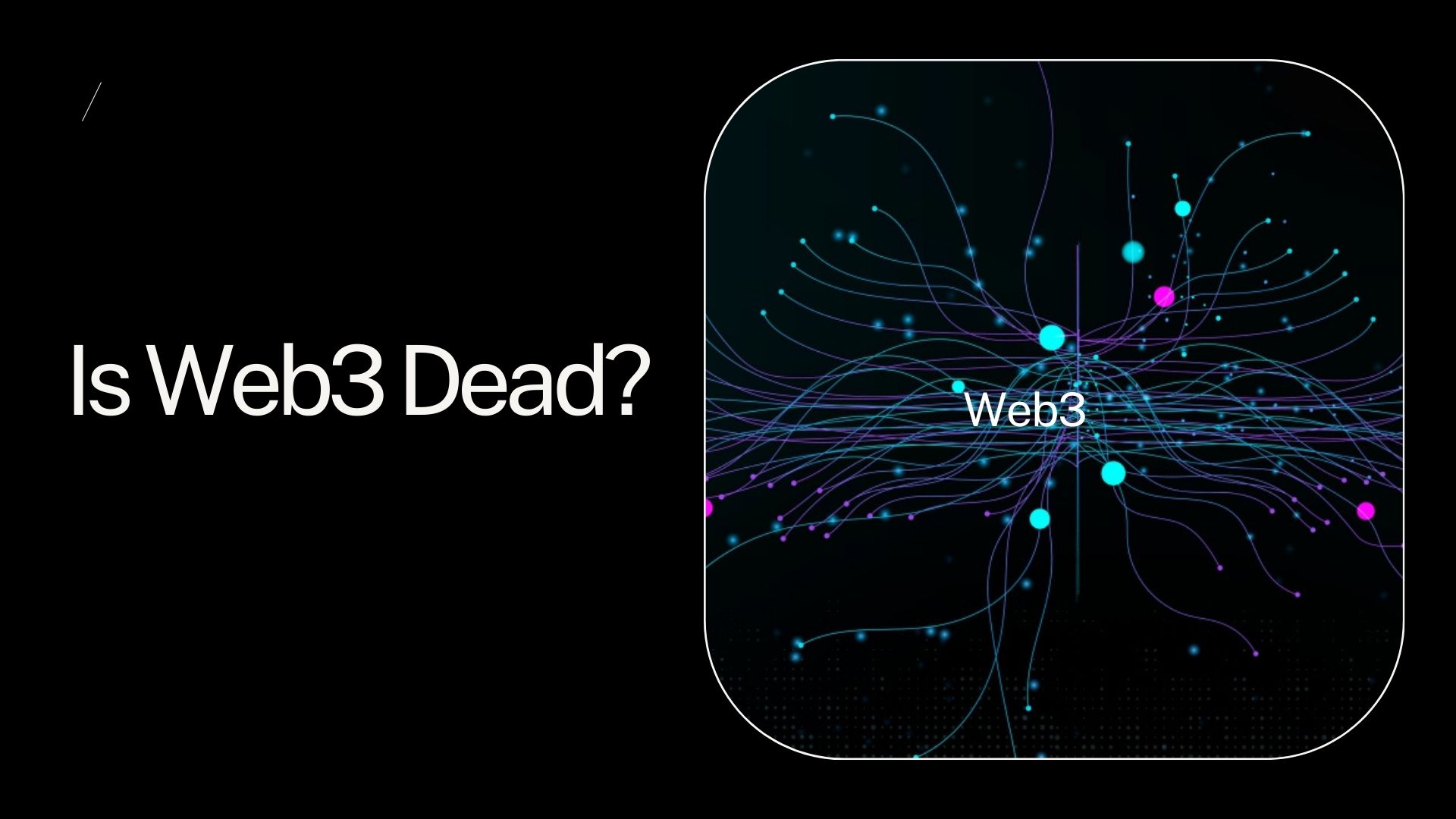Web3 is a term that refers to a decentralized internet based on blockchain technologies, such as cryptocurrencies, non-fungible tokens (NFTs), decentralized autonomous organizations (DAOs), and more. Web3 promises to offer many benefits for users, such as user ownership, financial inclusion, innovation, and transparency. However, Web3 also faces many challenges, such as environmental impact, regulatory uncertainty, security risks, and user adoption. In this article, i will look at the question Is Web3 Dead in 2023? I will argue that Web3 is not dead in 2023, but it faces significant obstacles and opportunities that will shape its future development and adoption.
Environmental impact
One of the main challenges of Web3 is its environmental impact. Web3 technologies, especially blockchain, consume a lot of energy and emit greenhouse gases. For example, Bitcoin, the most popular cryptocurrency, has a carbon footprint comparable to that of New Zealand or Argentina. NFTs, which are digital tokens that represent unique and scarce assets, also consume a lot of energy when they are created and traded on blockchain networks.
The environmental impact of Web3 affects its public perception, social responsibility, and regulatory compliance. Many people are concerned about the sustainability of Web3 and its contribution to climate change. Some governments and regulators are also imposing stricter rules and taxes on Web3 activities to reduce their environmental impact. For example, China has banned cryptocurrency mining and trading due to its high energy consumption and carbon emissions.
However, there are also possible solutions or alternatives to reduce the environmental impact of Web3. One of them is to use green energy sources, such as solar, wind, or hydropower, to run Web3 technologies. Another is to use carbon offsets, which are projects that reduce or remove greenhouse gas emissions from the atmosphere, to compensate for the emissions of Web3 activities.
A third solution is to use layer 2 solutions, which are protocols that run on top of blockchain networks and process transactions faster and cheaper without compromising security or decentralization. A fourth solution is to use eco-friendly protocols, such as proof-of-stake or zero-knowledge proofs, which are more efficient and less energy-intensive than proof-of-work.
Regulatory uncertainty
Another challenge of Web3 is its regulatory uncertainty. Web3 technologies, especially cryptocurrencies and decentralized finance (DeFi), challenge the existing legal and financial systems. Cryptocurrencies are digital currencies that operate independently of central authorities and intermediaries. DeFi is a term that refers to various financial applications that run on blockchain networks and offer services such as lending, borrowing, trading, investing, and more.
Both cryptocurrencies and DeFi have advantages such as lower costs, faster transactions, greater accessibility, and more innovation. However, they also have drawbacks such as volatility, lack of consumer protection, legal ambiguity, and compliance issues.
One of the main sources of regulatory uncertainty for Web3 is the lack of clear definitions, standards, and rules for digital assets, smart contracts, and DAOs. Digital assets are any assets that exist in digital form, such as cryptocurrencies, NFTs, and tokens. Smart contracts are self-executing agreements that run on blockchain networks and enforce the terms and conditions of a contract.
DAOs are organizations that are governed by smart contracts and operate autonomously without human intervention. These concepts are new and often do not fit into the existing legal frameworks that regulate traditional assets, contracts, and organizations. For example, it is unclear whether digital assets should be treated as currencies, securities, commodities, or something else. It is also unclear whether smart contracts are legally binding and enforceable and who is liable for their outcomes. It is also unclear whether DAOs have legal status and rights and who is responsible for their actions.
The regulatory uncertainty of Web3 affects its innovation, adoption, and risk management. On one hand, the lack of regulation can foster innovation and experimentation by allowing developers and users to explore new possibilities and opportunities without restrictions. On the other hand, the lack of regulation can also create risks and challenges for developers and users who may face legal disputes, penalties, or losses due to unclear or changing rules.
For example, in 2022, the US Securities and Exchange Commission (SEC) sued Ripple Labs, the company behind the cryptocurrency XRP, for allegedly conducting an unregistered securities offering. The lawsuit caused XRP’s price to plummet and many exchanges to delist it. The case is still ongoing and could have significant implications for the future of cryptocurrencies and Web3.
However, there are also possible solutions or alternatives to address the regulatory uncertainty of Web3. One of them is self-regulation, which is the process of establishing and enforcing rules and standards by the Web3 industry itself, without external intervention. Self-regulation can promote best practices, ethical conduct, and consumer protection while preserving innovation and flexibility. Another solution is industry collaboration, which is the process of working together with other stakeholders, such as regulators, policymakers, academics, and experts, to create a common understanding and vision for Web3.
Industry collaboration can foster dialogue, education, and consensus while avoiding conflicts and confusion. A third solution is policy advocacy, which is the process of influencing and shaping the policies and regulations that affect Web3. Policy advocacy can represent the interests and needs of the Web3 community while informing and persuading the decision-makers. A fourth solution is a regulatory sandbox, which is a framework that allows Web3 innovators to test their products and services in a controlled environment with relaxed or waived rules. Regulatory sandbox can provide feedback, guidance, and support while reducing risks and costs.
Security risks
A third challenge of Web3 is its security risks. Web3 technologies, especially blockchain and smart contracts, are vulnerable to cyberattacks and human errors. Blockchain is a distributed ledger that records transactions and data in a secure and transparent way. Smart contracts are self-executing agreements that run on blockchain networks and enforce the terms and conditions of a contract. Both blockchain and smart contracts have advantages such as immutability, verifiability, and automation. However, they also have drawbacks such as complexity, irreversibility, and unpredictability.
One of the main sources of security risks for Web3 is hacking incidents, which are malicious attempts to compromise or manipulate blockchain networks, smart contracts, or digital assets. Hacking incidents can result in theft, loss, or damage of funds, data, or reputation. For example, in 2022, a hacker exploited a vulnerability in a DeFi protocol called BadgerDAO and stole over $120 million worth of cryptocurrencies. The hacker was able to bypass the security measures and drain the funds from the smart contracts that managed the protocol.
Another source of security risks for Web3 is fraud schemes, which are deceptive practices that aim to defraud or deceive Web3 users or investors. Fraud schemes can involve false or misleading information, fake or cloned websites, impersonation or phishing emails, or exit scams. For example, in 2022, a project called Squid Game Token launched a cryptocurrency inspired by the popular Netflix series and promised to reward holders with high returns. However, the project turned out to be a scam and the developers ran away with over $2 million after crashing the token’s price.
A third source of security risks for Web3 is code bugs, which are errors or flaws in the code of blockchain networks or smart contracts. Code bugs can cause unexpected or undesired outcomes, such as malfunctioning, freezing, or crashing of Web3 applications or services.
A fourth source of security risks for Web3 is user mistakes, which are errors or oversights made by Web3 users or investors. User mistakes can include losing or forgetting passwords or keys, sending funds to the wrong addresses, falling for scams or phishing attempts, or failing to follow security best practices. For example, in january 2023, Kevin Rose, a prominent investor, and podcaster, lost access to his NFT collection worth over $1 million after his account was hacked.
The security risks of Web3 affect its trustworthiness, reliability, and accountability. Many users and investors are wary of using or investing in Web3 technologies due to the high possibility of losing their funds or data. Some developers and innovators are also hesitant to build or launch new Web3 applications or services due to the high responsibility and liability they face. Moreover, some regulators and policymakers are concerned about the potential harm or abuse that Web3 technologies could cause to consumers, markets, or society.
However, there are also possible solutions or alternatives to mitigate the security risks of Web3. One of them is encryption, which is the process of transforming data into an unreadable form that can only be accessed by authorized parties. Encryption can protect data from unauthorized access, modification, or disclosure. Another solution is auditing, which is the process of examining and verifying the code, functionality, and performance of blockchain networks or smart contracts. Auditing can detect and fix any errors or vulnerabilities in the code before they cause any problems.
A third solution is testing, which is the process of running and evaluating the functionality and performance of blockchain networks or smart contracts under various conditions and scenarios. Testing can ensure that the code works as intended and meets the expectations and requirements of the users and developers. A fourth solution is education, which is the process of providing and acquiring knowledge and skills on how to use and secure Web3 technologies. Education can help users and investors avoid or prevent common mistakes and risks, as well as increase their awareness and understanding of Web3.
User adoption
A fourth challenge of Web3 is its user adoption. Web3 technologies, especially NFTs and DAOs, offer new opportunities for user empowerment and participation. NFTs are digital tokens that represent unique and scarce assets, such as art, music, games, collectibles, and more. DAOs are organizations that are governed by smart contracts and operate autonomously without human intervention. Both NFTs and DAOs have advantages such as creativity, diversity, community, and governance. However, they also have drawbacks such as complexity, cost, accessibility, and awareness.
One of the main sources of user adoption for Web3 is the growth of NFT markets, communities, and platforms. NFT markets are places where NFTs are created, bought, sold, or traded. NFT communities are groups of people who share a common interest or passion for NFTs. NFT platforms are applications or services that enable users to create, discover, or interact with NFTs. For example, in 2022, the total sales volume of NFTs reached over $10 billion, a 900% increase from 2021. Some of the most popular NFT platforms include OpenSea, Rarible, SuperRare, Foundation.
Another source of user adoption for Web3 is the emergence of DAOs for various purposes and sectors. DAOs are organizations that are governed by smart contracts and operate autonomously without human intervention. DAOs can have different goals and functions, such as managing funds, creating content, providing services, or supporting causes. DAOs can also have different structures and rules, such as membership, voting, proposals, rewards, or penalties. For example, in 2022, there were over 1, 000 active DAOs with over $4 billion worth of assets under management. Some of the most prominent DAOs include MakerDAO, Compound, Uniswap, Aave, and MolochDAO.
The user adoption of Web3 affects its value creation, distribution, and sustainability. On one hand, the user adoption of Web3 can create more value and opportunities for users and society. Users can benefit from owning, creating, or participating in Web3 technologies that offer them more freedom, control, and reward. Society can benefit from having more diversity, innovation, and transparency in Web3 technologies that challenge the status quo and empower the people.
On the other hand, the user adoption of Web3 can also create more challenges and risks for users and society. Users can face more complexity, cost, and competition in Web3 technologies that require them to learn new skills, pay high fees, or deal with market fluctuations. Society can face more inequality, instability, and uncertainty in Web3 technologies that disrupt the existing systems and institutions and create new problems.
However, there are also possible solutions or alternatives to increase the user adoption of Web3. One of them is interoperability, which is the ability of different Web3 technologies to communicate and work together with each other and with other systems. Interoperability can enhance the functionality, efficiency, and compatibility of Web3 technologies and make them more accessible and attractive to users.
Another solution is usability, which is the ease of use and satisfaction of Web3 technologies for users. Usability can improve the design, interface, and experience of Web3 technologies and make them more intuitive and enjoyable for users. A third solution is accessibility, which is the availability and affordability of Web3 technologies for users.
Accessibility can increase the reach, inclusion, and diversity of Web3 technologies and make them more equitable and fair for users. A fourth solution is awareness, which is the knowledge and understanding of Web3 technologies for users. Awareness can raise the interest, curiosity, and engagement of Web3 technologies and make them more appealing and relevant for users.
Web3 is not dead in 2023, but it faces significant obstacles and opportunities that will shape its future development and adoption. Web3 has environmental, regulatory, security, and user adoption challenges that need to be addressed with solutions or alternatives that balance its benefits and costs. Web3 also requires more collaboration, innovation, education, and regulation to achieve its full potential and impact for a better internet and society.
Web3 is not dead but alive. But it is also not alive but dead. It is both and neither. It is something else. It is what we make of it.



